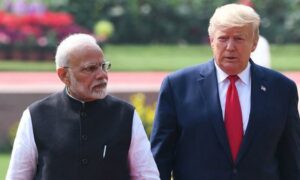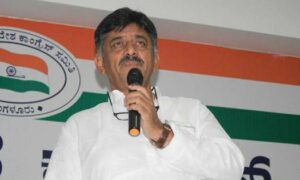
Gurugram was flooded yet again. Once more, outrage flares on social media; once more, daily life grinds to a halt. And once more, the city will soon forget. The city seems to be stuck in a familiar loop of angst during the crisis, apathy once it passes. The so-called Millennium City is unable to break free. Why is this so? Why has Gurugram, despite its wealth, failed so often as a city?
On the surface, Gurugram is one of India’s richest urban centres per capita, a collage of high-rise apartments, glass towers, international schools and sprawling malls. But beneath the sheen lies a profound absence. The city has no cultural core, no political presence, and little civic identity. Unlike Delhi, Mumbai or Kolkata, it has no monuments or historic institutions to bind its citizens together.
Until the 1990s it was a quiet agrarian district. Its transformation into a corporate suburb was driven almost entirely by developers like DLF and manufacturers like Maruti. The result is a city without memory and a site of only offices and condos, but not of history or shared belonging.
This absence of culture matters, because culture often provides the glue for civic life. Where cities lack cultural anchors, they struggle to generate civic identity or shared purpose. Gurgaon’s growth was developer-led, not citizen-led, which made the state a bystander. As political scientist James C Scott might say, it is an “illegible” city: chaotic, privately planned, with the state stepping in only to extract rent.
The consequences are visible in everyday dysfunction. Citizens have grown accustomed to water tankers instead of pipelines, diesel generators instead of reliable electricity, and potholes outside luxury condos. A city without a cultural or civic anchor is also a city without the capacity to demand better governance.
Gurgaon is drowning. Hours of rain have turned roads into rivers as cars stalled, shops flooded, commuters wading through knee-deep water. City’s drainage system collapses yet again. #GurgaonRains #Waterlogging@navdeepdahiya55 @shubhamtorres09 @IMD_Chandigarh pic.twitter.com/JyxiREcNd0
— Ipsita pati🌳 (@IpsitaTOI) September 1, 2025
Overshadowed by Delhi next door, Gurgaon has struggled to evolve a political or cultural personality of its own. While its residents orient themselves towards Delhi’s media, politics and cultural life, what remains locally is a patchwork of migrant subcultures like Bengali pujo committees, Punjabi gurdwaras, and Malayali associations, without ever cohering into a shared civic sphere.
A “public sphere,” after all, is where citizens debate common concerns and imagine themselves as part of a collective. Gurugram never developed one; its gaze is outward to Delhi rather than inward to itself.
The sociologist Marc Augé’s idea of “non-places” helps explain this absence. Non-places such as airports, malls, highways are designed for transit and consumption rather than belonging. Gurugram is built almost entirely out of such spaces: Cyber Hub, Ambience Mall, expressways and glass towers. Its residents therefore inhabit the city less as citizens and more as consumers.
Urbanists often distinguish between urbanisation, which is the mere growth of people and buildings, and urbanism, a civic culture that nurtures cosmopolitan identity. Gurugram has achieved the first but not the second. What fills the gap is not community but anomie: alienation, loneliness, and weak social bonds, even in the midst of affluence.
This has created a peculiar form of “privatised citizenship”. Gurugram’s middle class depends on private schools, hospitals, security and water rather than the state. When citizens self-provide, they also withdraw from politics: if the state offers nothing, why invest in it?
Residents focus more on symbolic national debates than on the material politics of roads, garbage and drains. The state, in turn, has little incentive to invest in Gurugram, where voter turnout is low and service delivery is replaced by private markets. A vicious cycle follows of neglect by the state, privatisation by citizens, further neglect.
“This is not the first time. Every monsoon, the same story repeats.
Gurgaon, ’ , home to Fortune 500 companies, luxury apartments, global consultants, yet just a few hours of rain and the , … pic.twitter.com/ADIlvPo9Fs
— PrashantAdvait Foundation (@Prashant_Advait) September 4, 2025
Meanwhile, Haryana’s politics remains firmly rooted in its villages, driven by caste and agrarian concerns. Gurugram’s economic power does not translate into political clout because the rural vote banks dominate. The tension between an economically powerful city and a politically powerful countryside runs through the state and explains why Gurugram’s crises never become the state’s priority.
Gurugram embodies India’s neoliberal turn: privatisation, deregulation, developer-driven growth. Yet this supposed utopia is fragile, sustained by generators, borewells, water tankers and malls that paper over public failure. The question is whether Gurugram’s residents will ever demand the basics of governance or whether the city will continue drifting from one flood to the next, trapped in its familiar loop of outrage and apathy.
Nikhil Agrawal is a Gurugram-based professional with a keen interest in Indian history, culture, and politics.
This article first appeared on Scroll.in
📰 Crime Today News is proudly sponsored by DRYFRUIT & CO – A Brand by eFabby Global LLC
Design & Developed by Yes Mom Hosting






